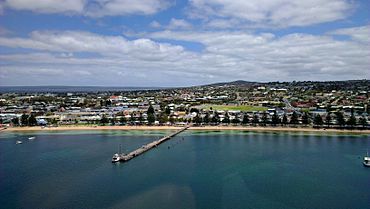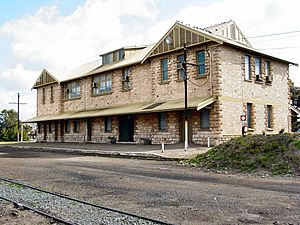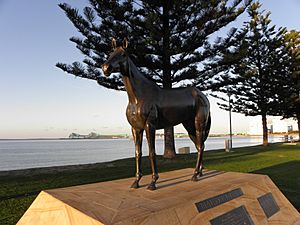Port Lincoln facts for kids
Quick facts for kids Port LincolnSouth Australia |
|||||||||||||||
|---|---|---|---|---|---|---|---|---|---|---|---|---|---|---|---|

Port Lincoln
|
|||||||||||||||
| Established | 1839 | ||||||||||||||
| Postcode(s) | 5606 | ||||||||||||||
| Elevation | 7 m (23 ft) | ||||||||||||||
| Time zone | ACST (UTC+9:30) | ||||||||||||||
| • Summer (DST) | ACST (UTC+10:30) | ||||||||||||||
| Location | |||||||||||||||
| LGA(s) | City of Port Lincoln | ||||||||||||||
| Region | Eyre Western | ||||||||||||||
| County | Flinders | ||||||||||||||
| State electorate(s) | Flinders | ||||||||||||||
| Federal Division(s) | Grey | ||||||||||||||
|
|||||||||||||||
|
|||||||||||||||
| Footnotes | Adjoining localities | ||||||||||||||
Port Lincoln is a city located on the Lower Eyre Peninsula in the Australian state of South Australia. The traditional owners, the Barngarla people, call it Galinyala. The city sits on the edge of Boston Bay, which opens into Spencer Gulf.
Port Lincoln is the biggest city in the West Coast region. It is about 280 kilometers (174 miles) by air from Adelaide, the state's capital. By road, it's about 646 kilometers (401 miles).
In June 2019, Port Lincoln had an estimated population of 26,418 people. The city is sometimes called Australia's "Seafood Capital" because of its large fishing industry.
Contents
History of Port Lincoln and Its Name
Early History and Traditional Owners
Aboriginal Australians have lived on the Eyre Peninsula for over 40,000 years. The main groups when Europeans arrived were the Barngarla people (eastern Eyre, including Port Lincoln), Nauo people (southwestern Eyre), Wirangu (northwestern Eyre), and Mirning people (far western Eyre).
The Barngarla people are recognized as the traditional owners of the land where Port Lincoln is. Their name for the area, Galinyala, means "place of sweet water" in the Barngarla language.
European Exploration and Naming
Matthew Flinders was the first European to explore the Port Lincoln area. He was sent by the British to map Australia's coast. On February 25, 1802, Flinders sailed his ship, HMS Investigator, into the harbor. He later named it Port Lincoln after his home city of Lincoln in England. A few months later, on April 19, Nicolas Baudin also visited the same port and named it Port Champagny.
Whalers and sealers visited the area from around 1828 to the 1840s.
Choosing a Capital City
In 1836, Governor Sir John Hindmarsh asked Colonel William Light to find a capital city for the new British province of South Australia. Many immigrants were arriving, and settlers were already waiting in other areas. Light needed to find a place with a good harbor, enough farmland, and fresh water.
England told Light to consider Port Lincoln as a possible capital. While Thomas Lipson had liked Port Lincoln's "beautiful harbor" and "fertile land," Light had doubts. He faced strong winds and tricky islands when he arrived. He thought it would be dangerous for ships and that there wasn't enough good farmland or fresh water for a large city. So, he chose Adelaide as the best place for the capital.
First Settlers and Growth
Even though it wasn't chosen as the capital, Port Lincoln became popular with pioneers. The first settlers arrived on March 19, 1839. On October 3, 1839, Governor George Gawler named the entire area from Cape Catastrophe to the head of the Spencer Gulf the District of Port Lincoln.
By 1840, Port Lincoln had 270 people, 30 stone houses, a hotel, a blacksmith's shop, and a store. Around this time, Edward John Eyre explored the peninsula, which was later named after him.
In the early 1840s, there were challenges between the local Aboriginal people and the British settlers. Governor George Grey sent soldiers to help keep control. By the end of 1843, British authority was fully restored.
Local Government and City Status
Local government officially started on the Eyre Peninsula on July 1, 1880. The town of Port Lincoln was part of this area. On August 18, 1921, Port Lincoln was officially declared a Municipality.
By 1936, the population had grown to 3,200. The port became very important for trade and farming in the area. Port Lincoln was granted city status on January 21, 1971. This was announced at the opening of the tenth annual Tunarama Festival.
Water Supply Challenges
A lack of reliable fresh water was one reason Port Lincoln wasn't chosen as the capital in the 1830s. Even as a small town, it grew faster than its water supply. Today, Port Lincoln gets most of its water from underground water sources in the southern part of the peninsula.
The southern and western parts of the Eyre Peninsula also share this water through the Tod-Ceduna pipeline. The Tod Reservoir, which used to provide drinking water, was stopped in 2001–2002 due to concerns about pollution and salt levels. The government is now looking into new ways to get water, like desalination (removing salt from seawater).
Historic Places in Port Lincoln
Port Lincoln has several places listed on the South Australian Heritage Register. These include:
- Dorset Place: Old Mill Lookout
- Hawson Place: Hawson's Grave
- 152 Proper Bay Road: Arrandale
- Railway Terrace: Port Lincoln railway station
- 36 Washington Street: Port Lincoln Police Station and Courthouse
- 20 Windsor Avenue: Ravendale House
Port Lincoln's Population
In June 2018, Port Lincoln had an estimated population of 26,326 people. About 5.6% of Port Lincoln's population are Aboriginal people.
Geography and Climate
Coastal Landscape
Port Lincoln has a varied coastline. It has calm, sheltered waters and beaches, as well as surf beaches and rugged ocean cliffs. The Great South Australian Coastal Upwelling System brings cold, nutrient-rich water into the nearby waters. This helps support many valuable fisheries, like those for southern bluefin tuna and sardines.
Weather in Port Lincoln
Port Lincoln has a warm-summer Mediterranean climate. The weather can change a lot because the town is between the dry Outback and the Southern Ocean. Summers often have cool sea breezes, keeping temperatures below 30°C (86°F). But sometimes, hot winds from the north can push temperatures over 40°C (104°F).
Winters are cool and cloudy, with frequent light rain and cold fronts. Frost is very rare. Temperatures range from an average high of 26.2°C (79.2°F) in January to 16.1°C (61.0°F) in July. Average low temperatures vary from 16.1°C (61.0°F) in February to 7.2°C (45.0°F) in August.
The average yearly rainfall is about 392.5 mm (15.45 inches). The wettest month on record was June 1981, with 200.4 mm (7.89 inches) of rain. Even with low rainfall, there are many cloudy days. Extreme temperatures have ranged from -0.3°C (31.5°F) to 48.3°C (118.9°F).
| Climate data for Port Lincoln (34º36'00"S, 135º52'48"E, 9 m AMSL) (1992-2024 normals and extremes, sun 1973-1991) | |||||||||||||
|---|---|---|---|---|---|---|---|---|---|---|---|---|---|
| Month | Jan | Feb | Mar | Apr | May | Jun | Jul | Aug | Sep | Oct | Nov | Dec | Year |
| Record high °C (°F) | 48.3 (118.9) |
44.4 (111.9) |
43.3 (109.9) |
39.5 (103.1) |
32.7 (90.9) |
27.3 (81.1) |
24.1 (75.4) |
31.2 (88.2) |
35.9 (96.6) |
40.8 (105.4) |
45.8 (114.4) |
45.6 (114.1) |
48.3 (118.9) |
| Mean daily maximum °C (°F) | 26.2 (79.2) |
25.9 (78.6) |
24.4 (75.9) |
22.3 (72.1) |
19.5 (67.1) |
16.8 (62.2) |
16.1 (61.0) |
16.8 (62.2) |
18.7 (65.7) |
21.0 (69.8) |
23.0 (73.4) |
24.7 (76.5) |
21.3 (70.3) |
| Mean daily minimum °C (°F) | 15.8 (60.4) |
16.1 (61.0) |
14.7 (58.5) |
12.2 (54.0) |
10.3 (50.5) |
8.5 (47.3) |
7.4 (45.3) |
7.2 (45.0) |
8.0 (46.4) |
9.6 (49.3) |
12.0 (53.6) |
14.0 (57.2) |
11.3 (52.4) |
| Record low °C (°F) | 8.5 (47.3) |
6.8 (44.2) |
6.7 (44.1) |
5.1 (41.2) |
3.0 (37.4) |
0.7 (33.3) |
−0.3 (31.5) |
1.3 (34.3) |
0.1 (32.2) |
2.3 (36.1) |
4.1 (39.4) |
5.2 (41.4) |
−0.3 (31.5) |
| Average precipitation mm (inches) | 19.6 (0.77) |
15.5 (0.61) |
16.5 (0.65) |
21.1 (0.83) |
41.8 (1.65) |
62.0 (2.44) |
55.2 (2.17) |
52.3 (2.06) |
39.3 (1.55) |
29.1 (1.15) |
21.4 (0.84) |
18.3 (0.72) |
392.5 (15.45) |
| Average precipitation days (≥ 0.2 mm) | 4.7 | 3.7 | 5.8 | 8.5 | 14.9 | 17.2 | 18.2 | 18.0 | 13.7 | 9.6 | 6.8 | 6.0 | 127.1 |
| Average afternoon relative humidity (%) | 50 | 52 | 54 | 57 | 61 | 66 | 66 | 64 | 62 | 56 | 52 | 51 | 58 |
| Average dew point °C (°F) | 12.2 (54.0) |
12.8 (55.0) |
12.0 (53.6) |
10.8 (51.4) |
9.6 (49.3) |
8.9 (48.0) |
8.1 (46.6) |
8.0 (46.4) |
8.7 (47.7) |
8.7 (47.7) |
10.0 (50.0) |
11.0 (51.8) |
10.1 (50.1) |
| Mean monthly sunshine hours | 294.5 | 245.8 | 223.2 | 183.0 | 151.9 | 129.0 | 155.0 | 179.8 | 189.0 | 229.4 | 243.0 | 272.8 | 2,496.4 |
| Percent possible sunshine | 67 | 65 | 59 | 54 | 48 | 44 | 50 | 53 | 53 | 57 | 58 | 61 | 56 |
| Source: Bureau of Meteorology (1992-2024 normals and extremes, sun 1973-1991) | |||||||||||||
Port Lincoln's Economy
Main Industries
Port Lincoln's economy relies on its large grain-handling facilities, which can hold over 337,500 tonnes of grain. It also has canning and fish processing factories. Other important products include lambs, wool, and beef.
A major industry is tuna farming for the Japanese market. Port Lincoln is home to Australia's largest commercial fishing fleet. It also has a growing aquaculture industry, which is like farming in water. They farm species such as southern bluefin tuna, yellowtail kingfish, abalone, mussels, oysters, and even some seahorses and spiny lobsters. Before aquaculture, the main fishing was for southern bluefin tuna.
The city is also a regional hub for government services and businesses for the Eyre Peninsula.
Tourism in Port Lincoln
Port Lincoln is a popular place for tourists. Its location on both Spencer Gulf and the Great Australian Bight makes it great for yachting, scuba diving, and game fishing. You can even go shark cage diving!
Nearby natural attractions include Lincoln National Park, Coffin Bay National Park, and Kellidie Bay Conservation Park. These parks are perfect for exploring the local wildlife and scenery.
Transportation in Port Lincoln
Rail and Air Travel
The Port Lincoln railway station is the end point of the Eyre Peninsula Railway. This railway has narrow gauge tracks and connects Port Lincoln to other towns like Kevin, Cummins, Buckleboo, and Yeelanna.
Port Lincoln Airport is just a few kilometers north of the city. Airlines like Regional Express and QantasLink offer several daily flights to Adelaide, the state capital.
Bus Services
The Port Lincoln Bus Service runs Monday to Friday, serving different parts of the city. For longer journeys, Stateliner operates daily bus services to Adelaide and Port Augusta.
Culture and Media
Port Lincoln in Books and Movies
The book Blue Fin by Colin Thiele was set in Port Lincoln. The movie based on the book was filmed nearby in Streaky Bay.
Some scenes for the movie Gallipoli were filmed near Port Lincoln. The first season of Australian Survivor was filmed at Whalers Way, south of Port Lincoln, in 2001.
The Discovery Channel documentary series Tuna Wranglers (2007) and Abalone Wars were both filmed in and around Port Lincoln.
In the TV show Neighbours, the Brennan brothers (Tyler, Mark, and Aaron) are originally from Port Lincoln. The town was also featured in the second series of An Idiot Abroad, where British comedian Karl Pilkington swam with sharks.
Local Media
Port Lincoln has one local newspaper, the Port Lincoln Times. It is published on Tuesdays and Thursdays.
The city has two local commercial radio stations: 89.9 Magic FM and 765 AM 5CC. It also receives ABC West Coast SA on 1485 AM, Triple J, ABC Radio National, and ABC News Radio on 91.5FM.
Free-to-air TV channels available in Port Lincoln include ABC, SBS, Seven GTS/BKN, the Nine Network, and Southern Cross Ten. Foxtel pay TV is also available.
Sports in Port Lincoln
The most popular sports in Port Lincoln are tennis, Australian rules football, soccer, netball, and basketball. The Port Lincoln Football League (PLFL) has 6 teams. The Mallee Park Football Club is known for producing many Australian Football League players.
The Centenary Oval can hold 7,500 people and has hosted popular pre-season AFL matches. The Port Lincoln Soccer Association runs a four-team competition.
Twin Towns
Port Lincoln is twinned with:
 Lincoln, United Kingdom
Lincoln, United Kingdom
Notable People from Port Lincoln
Many talented people have come from Port Lincoln, including:
- Eddie Betts – An Australian rules football player.
- Peter Burgoyne – An Australian rules football player.
- Shaun Burgoyne – An Australian rules football player.
- Kyle Chalmers – An Olympic swimmer who won medals in 2016 and 2020.
- Graham Johncock – An Australian rules football player.
- Dean Lukin – A weightlifter who won an Olympic Gold Medal in 1984. He was also a tuna fisherman.
- Harry Miller – An Australian rules football player.
- Kieran Modra – A visually impaired Paralympic cyclist, born in Port Lincoln.
- Lauren Nourse – An Australian netball player who started her career in Port Lincoln.
- Byron Pickett – An Australian rules football player.
- Tony Santic – A racehorse owner and tuna farmer, who owned Makybe Diva, the only horse to win the Melbourne Cup three times.
- Lindsay Thomas – An Australian rules football player.
- Daniel Wells – An Australian rules football player.
- Bianca Woolford – A para-cyclist.
Images for kids
See also
 In Spanish: Port Lincoln para niños
In Spanish: Port Lincoln para niños






